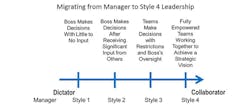Last week I had an epiphany. It was one of those “Ah-ha” moments that impacts you like a sledgehammer hitting you in the chest. The realization was in regard to the question, “If there is so much evidence that lean and Six Sigma dramatically improves efficiencies and quality (enhancing the customer experience), why is it still so difficult to get executives and middle managers to fully support and embrace the initiative?” An answer to this question became clear during a workshop I was facilitating for Virginia Tech’s “Implementing Lean for Operational Excellence” annual conference.
Two weeks prior to the conference, to prepare to deliver a keynote speech, I asked a question on social media: If you had one word to describe the MAIN ingredient to sustaining and expanding an improvement initiative (lean, Six Sigma, etc.), what would it be?” Over 100,000 people participated in providing feedback. I took all of the words that were supplied and created a word cloud (the size of the word indicates how many times that word was submitted).
The results are below:
Take notice of the two largest words: leadership and commitment. These were followed closely by culture and buy-in. You may also notice words like engagement, people, communication, trust and vision. These are all words associated with the questions: How do we improve our organization’s culture? Why won’t my leaders fully and wholeheartedly commit to something that seems so obvious to many of us trying to make a difference? What will it take to get my boss to fully buy in to allowing teams of employees the opportunity to improve the way things are done (and at the same time, how do we get the employees to trust us and fully buy in as well)?
In the keynote speech, I spoke about the differences between management and leadership as well as the four styles of leadership (this is covered in my last article Why Do Good Leaders Fail? The Leadership Spectrum in Action) and how each style is needed when given a certain set of circumstances the organization is going through. In addition to the speech, I was asked to run a workshop that tied directly into the topics covered. Over this past year, I have been developing an activity that shows the differences between management, style 1 leadership (the leader makes all of the decisions but also explains the why and how) and style 4 leadership (fully empowered teams that, with guidance and support from the leader, make things happen).
The activity consists of three rounds. In the first round, a group of volunteer employees are asked to complete a task. They are not able to see the task and they must rely on another volunteer “manager” to tell them what to do. However, unbeknownst to the manager, each employee has their own set of objectives (management by objectives). Some of these objectives conflict with what the other employees are trying to accomplish. Chaos soon breaks out, and the task does not get close to being completed. The manager continues to bark out orders trying to control the chaos and usually becomes quite frustrated. It is easy to observe that as the frustration level goes up, the manager becomes more and more irritated with the employees and will either start yelling at them (which usually demotivates the volunteer employees, making the situation worse) or throws their hands up and quits.
In round two, the manager is substituted with a “style one leader.” The employees are given the same task to complete (still unable to see what is happening and relying on their leader to provide direction) but this time, the leader explains the purpose of the activity and the employees’ individual objectives are replaced with a focus on doing what they can to help the system function. The leader then begins to bark out orders (just like the manager), but this time the leader also provides feedback and explains what is happening with some encouragement. In round two, the easier parts of the task are completed, but the more difficult portions are usually not done before time runs out.
In round three, the style one leader is replaced with a “style four leader.” This new leader explains what the task is and what success looks like (mission and vision). The leader then asks for input from the employees and, once they have a plan, turns them loose to work on the task and make their own decisions. The results are staggering. Not only does the full task get completed, but also the employees are able to finish in a fraction of the time. Once the task is done, there is genuine excitement with “high fives” given out by the leader as well as the employees. Comments are shared such as, “That was great! Look what we accomplished! I bet we could do the task even faster the next time!”
Now for the epiphany… I asked the participants, “Which round would best represent an organization you would want to work for as an employee?” Everyone agrees that round 3 would be the best by far. I then ask the participants to describe the three bosses. The round 1 “manager” is described as a tyrant who uses fear to try and get things done. But there is also some sympathy given as the manager tried to control the chaos (herding cats, so to speak). The “style one leader” in round 2 gets better feedback, but everyone usually agrees that the boss quickly became the bottleneck since people could not really do anything without first getting directions from the leader. The “style four leader” in round 3 is given the most praise. Comments such as “a real visionary… shifted from leader to cheerleader during the execution phase… very motivational” are common.
However, I then asked the group which boss, based on how they performed, would most likely get recognized and promoted? Then came the Ah-ha moment… “Probably the first boss… the round 1 manager because she looked like she was the busiest and the most in charge of what was happening,” said one participant. “Yeah, I hate to agree,” said another participant. “But in my organization, the executives seem to reward how much in control someone is, and I bet many executives would see the round 3 boss as someone who is not fully engaged during the execution phase and might even ask the question, ‘Why do we need that person?’”
So, many of the same insecurities that the workers feel whenever a lean or Six Sigma initiative is started (Am I going to lose my job? How will my work change? Will I be shouldered with more or less responsibility? Will my importance in the organization be reduced?) are also shared by the organization’s bosses. These insecurities manifest themselves in a number of ways.
One participant stated that her boss was fully supportive of their lean initiatives, however, he was too busy to attend any of the training or do any more than call into team report-outs after an improvement event (busyness = effectiveness). Another boss kept bragging that he got over 200 emails a day and just did not have time to walk out to the shop floor to see the problems (e-mails = importance). Another said that they were in meetings all day and just did not have any time on their schedule to fit in a discussion on ways to support the teams (attending meetings = accomplishments). One other boss said that she was fully supportive of a lean initiative and freed up a significant amount of money in the budget to fund several full-time resources. However, she did not plan on changing how she managed or how she measured success of any of the supervisors who reported into her (financial support = commitment).
The new normal for how bosses are measured for effectiveness needs to change.
I believe that Dr. W. Edwards Deming tried repeatedly to get this message across to U.S.-based executives. One story I heard recently about Dr. Deming’s interaction with the Ford Motor Co.’s leaders in the early 1980s went something like this: Henry Ford II invited Dr. Deming in to help them improve quality of their cars (It is believed that Ford was one of the first U.S. companies to recognize Dr. Deming’s teachings and impact and ask for help.). Dr. Deming walked up to Mr. Ford in their introductory meeting, poked him in the chest and said that the poor quality of Ford’s cars were the fault of Mr. Ford himself. He said that 96% of quality issues are directly related to the system and that Mr. Ford and his leadership team were responsible for the system. And, until he changed his ways, the rest of the company had no hope. Fortunately, Mr. Ford did not throw Dr. Deming out of his office. He agreed to listen and to change the way he and other leaders did things. This interaction resulted in the genesis of the Ford Taurus, which went on to become one of the best-selling cars in Ford’s history.
The New Normal
So, what does the new normal look like for an organization with “style four leaders”? Priorities will shift as well as how these leaders spend their time. Since day-to-day decisions are now made by the people on the team closest to the process work and as processes improve there will be less chaos, the leader’s time in meetings and reading e-mails will drop significantly. So, what will the style four leader do with this freed up time?
- Spend more time with the internal and external customers to learn firsthand how the organization is meeting their needs.
- Spend more time talking to employees where the process is happening in order to learn what is working and what needs to be improved.
- Recruit and hire (along with members from the team) outstanding new team members. Provide mentoring and coaching to help develop employees as needed.
- Craft (with input from all sources) and get employee, customer and shareholder buy-in for a two- to three-year vision of where the organization is going that is so inspirational and motivational that employees and customers can’t help but to want to be a part of the organization’s success.
- Study the overall system and data to look for ways individual processes interact to produce goods and services. Deploy resources to the teams as needed to address the improvement opportunities with the highest return.
- Become a cheerleader to help provide motivation and inspiration to make sure every employee understands how important they are to the success of the organization.
Have faith in the following equation:
A product/service people want + a well-defined system of many outstanding processes + motivated, well-trained teams of people + an inspirational vision to aid decision-making + communication of data and feedback = a great business model that will help assure that the organization continues to fulfill its mission, now and into the future.
So, instead of recognizing the bosses who appear to be the busiest or the most important or who think they need to be in control, HR professionals, CEOs, owners, presidents, etc., need to promote the leaders who have the best teams of employees, with the highest engagement and morale, utilizing the best systems and processes. Recognize these leaders for what they are: superstars in the organization. Until this new normal becomes a reality in your organization, prepare to continue to wonder why the boss refuses to fully embrace lean or any other improvement initiative.





